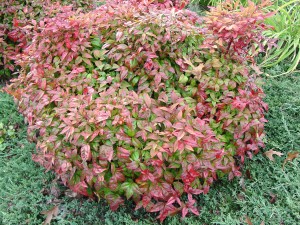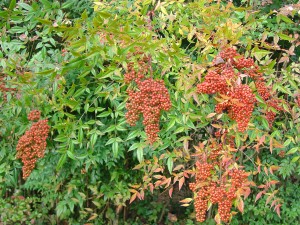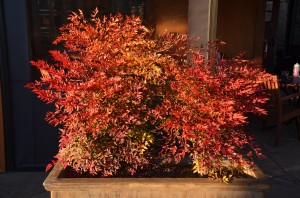Aka “heavenly bamboo”, nandinas (Nandina domestica) are broadleaf evergreen shrubs with several landscape attributes that include white spring flowers, color changing leathery foliage, and enormous clusters of colorful berry fruits in fall and winter (USDA hardiness zones 6-9).
This member of the Barberry family (Berberidaceae) is native to Japan, China and India. Foliage is variable, semi-evergreen to deciduous in northern areas in zones 6-7, and evergreen in zones 8-10. Some cultivars may die back to the ground during harsh winter and grow fully back by late spring.
Depending on cultivar, nandinas grow 4 to 8 feet tall and 2 to 4 feet wide with upright branching. Shrubs form erect, cane-like stems and compound leaves that some people may mistake as bamboo. Leaves comprise bi- or tri-pinnately compound that give it a fine textured appearance. They possess a rhizomatous rootsystem.
Depending on location, white panicle flowers appear in mid- to late-summer, 8-15 inches in length. Bright red ¼ inch berries follow in the fall and persist through winter. Cultivars ‘Leucocarpa’ and ‘Alba’ produce cream-colored berries. Deer leave nandinas alone. Fruits are rated poisonous to deer, other grazing animals and house pets.
Nandinas grow in average, medium moist, well-drained soils and in full sun to partial shade; they are shade tolerant. Soil pH may be either acidic to slightly alkaline. Leaves turn chlorotic in high pH (alkaline) soils.
Group or mass nandinas for optimum effect in shrub borders, home and building foundations, or open woodland areas. Nandinas are frequently utilized as low informal hedges in warm winter climates where foliage remains evergreen.
Note: nandinas are considered highly invasive in some southern states.
Popular Cultivars:
‘Firepower’ – popular dwarf, very compact 2 feet tall and wide shrub; lime-green foliage turns bright red in late fall thru winter; fruits sparingly.
Harbour Dwarf™ – compact 18 to 24 inches shrub; spring leaves emerge with coppery tints, green in summer, and bronzy-red in fall and winter; fruits sparingly.
Harbor Belle™ – dwarf, compact 18 to 24 inches shrub; spring leaves glossy green with pink tint, dark green by early summer; burgundy splashed in fall through winter; heavy load of bright red fruits in fall thru winter.
Gulfstream™ – compact growing 3-4 feet tall non-suckering shrub; medium green summer foliage turns orange-red winter in fall through winter; fruits sparingly; non-suckering.
Moonbay™ – sister seedling of ‘Gulfstream’, this dwarf variety grows 3-4 feet tall and wide; spring foliage emerges lime green, turns to medium green by early summer, and orange to red color in fall-winter; fruits sparingly; non-suckering.




 Posted in
Posted in 
